Reflection and Refraction of Light :)
Thursday, January 13, 2011
Wednesday, January 12, 2011
REFLECTION
Reflection
You probably look at your image in the mirror almost every morning. What you see in the mirror is an exact replica of you and your surroundings. You move your finger and your image move sits finger in exactly the same way. It seems your mirror has accomplished the amazing feat of duplicating objects. The mirror, however, has accomplished nothing. This duplication is the result of your eyes interpreting the light property of reflection.
Reflection occurs when a light ray travels from an object (such as your body), hits a reflective surface (such as a mirror) and is redirected to your eye. It is the redirection of the light that causes a duplicate image to be created. When light hits a flat, reflective surface, it hits at a specific angle. This angle in which the light strikes the surface is called the angle of incidence. This angle is measured from the surface's normal, an imaginary line that lies perpendicular to the surface. Upon hitting the surface the light ray reflects, or bounces, off of the surface at an angle called the angle of reflection. The angle of reflection, like the angle of incidence, is also measured from the normal. By the laws optics, this angle is always identical to the angle of incidence.
Wave Diagram
When you look into a full length mirror, you are able to see a room identical to the one in which you are standing. In the room of the mirror you can even perceive depth just as it appears in the actual room. Our eyes can create depth because a light ray reflected by the mirror from an object in the room reaches your eye at the same angle from which a ray from the virtual image in the mirror appears to be originating. This concept may be easier to grasp using the following example and diagram:
Reflection Diagram
On the right side of this diagram there is a man standing in front of a mirror with an orange sitting by his feet. When the man looks in the mirror he sees the reflection of the orange located at his reflection of his feet. Everything in the reflected image is positioned exactly as in the man's reality. Light rays from the orange reflect off of the mirror and reach the man's eyes, following the path of the green lines in the diagram. If there was actually an orange where the virtual image appears, light rays would reach the man along the path of the dotted red lines. The path of the dotted red lines matches the path of the solid green lines. Because the man's brain knows that light usually travels in a straight line, the light appears to be following the red lines so the brain misinterprets the signals and "sees" the image behind the mirror.
Try Reflection For Yourself:
Take a flashlight into a room with a large mirror. Stand in front of the mirror and shine your flashlight at the ceiling in the virtual image. You will see a spotlight on the ceiling of the reflected image in such a position that you can trace a straight line from the flashlight to the image of the spotlight. This straight line exists as if the reflection is simply an extension of the room and not simply an image. Now look above your head and you will see a spotlight on the actual ceiling in the same place in which it appears in the reflection. You can see by looking at the light on your real ceiling that the light has bent, but an image is created because the light is still interpreted by the brain to be traveling in a straight line.
You can have a lot of fun playing with the property of reflection. Although reflection sometimes appears to be a miraculous trick, it is only a simple optical principle and a misinterpretation of light.
REFRACTION
Broken Pencil Illusion
What has happened to this pencil? It was perfectly normal and intact until someone decided to pour water into the glass. What kind of water does that to a pencil? The water in this picture is actually not special at all: it is ordinary tap water. This pencil is still intact, but it appears distorted because of a property of light called refraction. Refraction causes light to bend when it passes from one substance into another, in this case from air to water. You can test this property with any object, not just a pencil. You may observe refraction affecting your own body when you are at the swimming pool. The parts of your body out of the water may not line up with the parts in the water. This distortion is all due to the bending of light.
The term "refraction" is not exclusive to light. Refraction refers to the turning or bending of any wave, such as light and sound, when it passes through a substance of differing density . Refraction does not occur when light passes from blue-colored water to red-colored water because both waters have the same densities. We most commonly see refraction occur when light passes between air, water and glass.
Tuesday, January 11, 2011
REFRACTION
Refraction of light waves is governed by the two Laws of Refraction:
- The incident ray, refracted ray and the normal at the point of incidence lie in the same plane.
- The sine of the angle of incidence bears a constant ratio with the sine of the angle of refraction for a given pair of media. This law is also known as the Snell's law, named after Willebrord Snell.
The process of refraction can be explained with the help of Huygens' construction:
Let us assume a surface separating two different media of different densities, medium 1 and medium 2, in which the speed of light is c1 and c2 respectively (refer to diagram).
Let us assume a surface separating two different media of different densities, medium 1 and medium 2, in which the speed of light is c1 and c2 respectively (refer to diagram).
A light beam travelling in medium 1, with velocity=c1 strikes the surface and enters medium 2. One of the light rays of the incident beam has a wavefront AB perpendicular to the direction of propagation. This wavefront, at time=0 reaches the point A, which lies on the surface separating the two media. This point, according to Huygens' principle becomes a secondary source of light and emits a secondary wavelet at time=0, into medium 2, with a velocity of c2. At time t, this secondary wavelet is in the form of a hemispherical surface of radius=c2t. At this time, its wavefront reaches a point C, which is on the surface separating the two media.
A tangent CD is now drawn from the point C to the secondary wavelet emitted by A. A point P is now considered on the surface which lies between A and C, such that AP/AC = x. Let there be two perpendiculars from P, PQ and PR, onto AB and AC.
A
When light travels from a rarer medium to a denser one, it bends towards the normal. When it travels from a denser medium to a rarer one, it bends away from the normal. This bending of light has many implications, one of which is quite prominent in nature - mirage.
A mirage occurs in very hot conditions, when a layer of warm air, next to the ground is trapped by the relatively cooler air above. Light is succesively bent by these different layers of different densities towards the horizontal line of vision and eventually is made to travel upwards by total internal reflection at one of these layers. When these light rays reach the human eye, the human brain perceives them as coming from the image of the object, beneath it, thus giving the wrong impression of a pool of water at some distance. This phenomenon is most prominent on long roads on very hot days and in hot deserts. Another type of mirage, called looming, occurs in extemely cold conditions, when a layer of relatively warm air, lies over another of cool air. The light rays travelling from the cold to the warm layer are bent away from the normal, and finally reflected downwards, to give an impression of an image looming above the real object.
The refraction of light can be used for various purposes. Water-filled spheres, known an lacemakers' condensors, were used in the early nineteenth century by lacemakers to help them see their work. Light passing through these condensors was bent in such a way, so that the rays meet in a small area and light up only a small area of the cloth to enable the lacemaker to focus on it. Another use of refraction is in Schlieren Photography, which uses the fact that air at different temperatures bends light by different amounts. The refractive index of a particular substance which occurs in a huge quantity such as a water reservoir can also be used to measure its real depth by measuring the apparent depth. Since light coming from a denser medium such as glass or water is bent away from the normal, the depth at which an object inside that medium appears to be less than its real depth.
As the angle of incidence for a light ray travelling in a denser medium incident on the surface separating it from a rarer medium increases, the angle of refraction also increases. There comes a certain angle of incidence for which the corresponding angle of refraction is 90, which is known as the critical angle. If the incident angle is more than this the entire light is reflected back into the same medium. This phenomenon is known as Total Internal Reflection. From SLR cameras and simple periscopes to optical fibres and endoscopes, this phenomenon has been used in many fields today. Total reflecting prisms are even more efficient than than mirrors.
REFLECTION OF LIGHT
Reflected waves are simply those waves that are neither transmitted nor absorbed, but are reflected from the surface of the medium they encounter. When a wave approaches a reflecting surface, such as a mirror, the wave that strikes the surface is called the incident wave, and the one that bounces back is called the reflected wave (refer to figure 2-4). An imaginary line perpendicular to the point at which the incident wave strikes the reflecting surface is called the normal, or the perpendicular. The angle between the incident wave and the normal is called the angle of incidence.
The angle between the reflected wave and the normal is called the angle of reflection.
Figure 2-4. - Reflection of a wave.
If the surface of the medium contacted by the incident wave is smooth and polished, each reflected wave will be reflected back at the same angle as the incident wave. The path of the wave reflected from the surface forms an angle equal to the one formed by its path in reaching the medium.
Heres a video of reflection of light.Just click the link below:
http://www.youtube.com/watch?v=T5oxC9l_u50
Heres a video of reflection of light.Just click the link below:
http://www.youtube.com/watch?v=T5oxC9l_u50
LIGHT REFRACTION
At first we will look at a simple refraction, one that happens at a flat boundary. Below is a picture of such a situation. Here a single ray of light strikes a boundary between two mediums and is refracted.
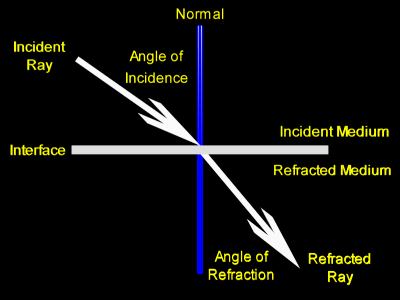 Here are descriptions for the terms in this diagram:
Here are descriptions for the terms in this diagram:
We will often describe the light beam as bending toward the normal or away from the normal. The following picture, much like the one directly above, shows light bending toward the normal. Again, this is the general behavior for light going from air into water or glass.
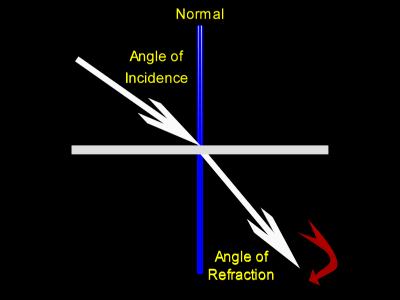 Here light bends toward the normal. The red arrow is meant to show what we mean by the phrase "bending toward the normal."
Here light bends toward the normal. The red arrow is meant to show what we mean by the phrase "bending toward the normal."
Notice that in these conditions the angle of refraction is smaller than the angle of incidence.
This next picture shows light bending away from the normal. This would be the general behavior for light going from water or glass into air.
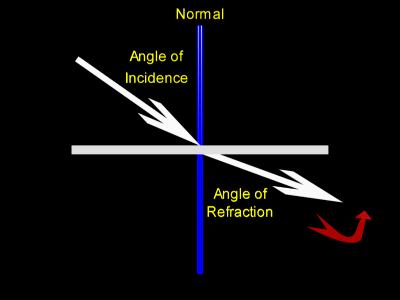 Here light bends away from the normal. The red arrow is meant to show what we mean by the phrase "bending away from the normal."
Here light bends away from the normal. The red arrow is meant to show what we mean by the phrase "bending away from the normal."
Notice that in these conditions the angle of refraction is larger than the angle of incidence.
The situations where light bends away from the normal can become more complicated than those where light bends toward the normal. This is because the angle of incidence can become large enough so that the angle of refraction, being even larger, can reach 90 degrees. This eliminates the possibility that the ray will enter the refracted medium. These conditions demonstrate what is known as a critical angle. Critical angles are covered in their own section.
Almost all of the time when light changes mediums, it changes direction. However, if it strikes the interface with an angle of incidence of 0 degrees, then no bending will occur. Here is what that looks like:
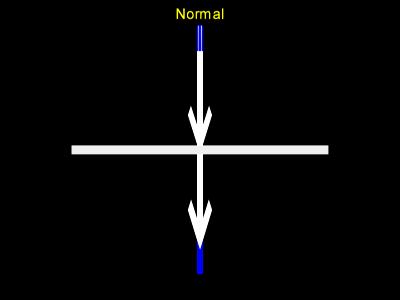
Also, there are a few conditions where light travels from one medium into another and does not bend for any angle of incidence. This happens when the two mediums are different substances, but have the same optical density. This situation will be covered in the explanation of Snell's law, which has its own section.

The above picture demonstrates the general behavior of a light ray as it travels from air into some transparent medium such as water or glass.
- The ray of light which travels through the incident, or first, medium and strikes the boundary, or interface, is called the incident ray.
- The ray of light which travels into the refracted, or second, medium and leaves the interface is called the reflected ray.
- A line perpendicular to the surface is imagined at the point of refraction. This line is called a normal. In this context the word normal means perpendicular. In the above diagram the normal is colored blue.
- The angle between the incident ray and the normal is called the angle of incidence, or the incident angle.
- The angle between the refracted ray and the normal is called the angle of refraction, or the refracted angle.
We will often describe the light beam as bending toward the normal or away from the normal. The following picture, much like the one directly above, shows light bending toward the normal. Again, this is the general behavior for light going from air into water or glass.
 Here light bends toward the normal. The red arrow is meant to show what we mean by the phrase "bending toward the normal."
Here light bends toward the normal. The red arrow is meant to show what we mean by the phrase "bending toward the normal."Notice that in these conditions the angle of refraction is smaller than the angle of incidence.
This next picture shows light bending away from the normal. This would be the general behavior for light going from water or glass into air.
 Here light bends away from the normal. The red arrow is meant to show what we mean by the phrase "bending away from the normal."
Here light bends away from the normal. The red arrow is meant to show what we mean by the phrase "bending away from the normal."Notice that in these conditions the angle of refraction is larger than the angle of incidence.
The situations where light bends away from the normal can become more complicated than those where light bends toward the normal. This is because the angle of incidence can become large enough so that the angle of refraction, being even larger, can reach 90 degrees. This eliminates the possibility that the ray will enter the refracted medium. These conditions demonstrate what is known as a critical angle. Critical angles are covered in their own section.
Almost all of the time when light changes mediums, it changes direction. However, if it strikes the interface with an angle of incidence of 0 degrees, then no bending will occur. Here is what that looks like:

Also, there are a few conditions where light travels from one medium into another and does not bend for any angle of incidence. This happens when the two mediums are different substances, but have the same optical density. This situation will be covered in the explanation of Snell's law, which has its own section.
SNELL'S LAW
Snell's Law relates the indices of refraction n of the two media to the directions of propagation in terms of the angles to the normal. Snell's law can be derived from Fermat's Principle or from the Fresnel Equations.
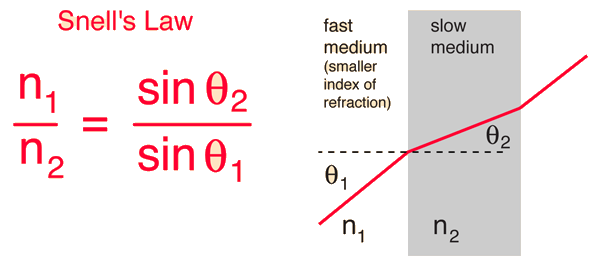
Enter data below, then click the symbol of the quantity you wish to calculate. Enter data and then click on the symbol for the quantity you wish to calculate in the active equation above. The numbers will not be forced to be consistent until you click on the quantity to calculate. Indices of refraction must be greater than or equal to 1, so values less than 1 do not represent a physically possible system.
If the incident medium has the larger index of refraction, then the angle with the normal is increased by refraction. The larger index medium is commonly called the "internal" medium, since air with n=1 is usually the surrounding or "external" medium. You can calculate the condition for total internal reflection by setting the refracted angle = 90° and calculating the incident angle. Since you can't refract the light by more than 90°, all of it will reflect for angles of incidence greater than the angle which gives refraction at 90°.

If the incident medium has the larger index of refraction, then the angle with the normal is increased by refraction. The larger index medium is commonly called the "internal" medium, since air with n=1 is usually the surrounding or "external" medium. You can calculate the condition for total internal reflection by setting the refracted angle = 90° and calculating the incident angle. Since you can't refract the light by more than 90°, all of it will reflect for angles of incidence greater than the angle which gives refraction at 90°.
Subscribe to:
Posts (Atom)


